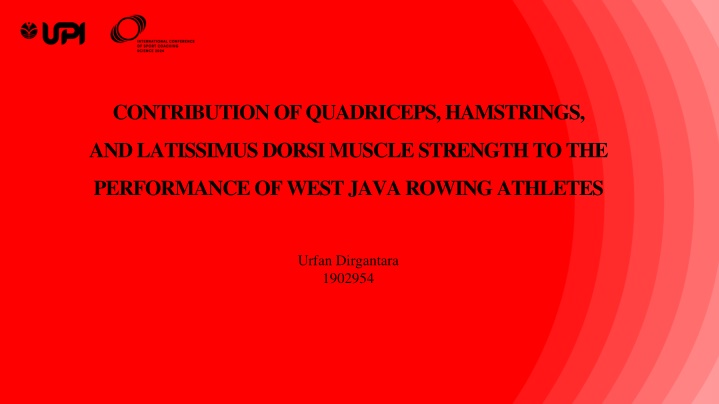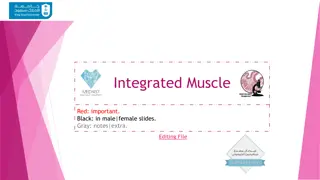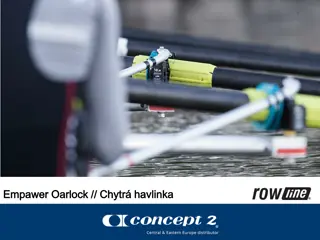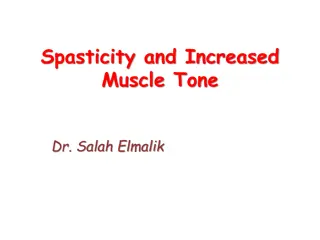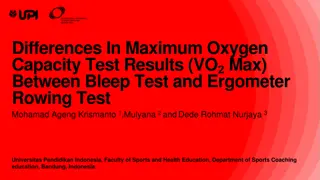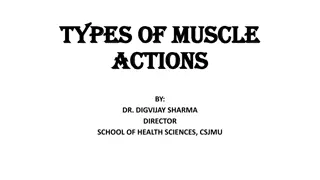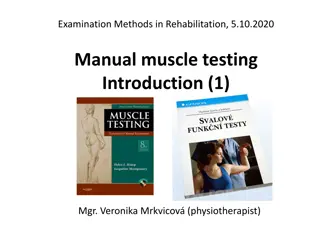Contribution of Quadriceps, Hamstrings, and Latissimus Dorsi Muscle Strength to Rowing Performance in West Java
Rowing is a demanding sport that requires strong leg muscle strength for optimal performance, particularly in West Java where rowing athletes train. This study aims to investigate the contribution of quadriceps, hamstrings, and latissimus dorsi muscle strength to the performance of rowing athletes in this region. The research seeks to identify which muscle group plays the most significant role in enhancing rowing performance through physical condition tests and correlation analysis. The results will aid in designing tailored training programs for rowing athletes in West Java.
Download Presentation

Please find below an Image/Link to download the presentation.
The content on the website is provided AS IS for your information and personal use only. It may not be sold, licensed, or shared on other websites without obtaining consent from the author.If you encounter any issues during the download, it is possible that the publisher has removed the file from their server.
You are allowed to download the files provided on this website for personal or commercial use, subject to the condition that they are used lawfully. All files are the property of their respective owners.
The content on the website is provided AS IS for your information and personal use only. It may not be sold, licensed, or shared on other websites without obtaining consent from the author.
E N D
Presentation Transcript
CONTRIBUTION OF QUADRICEPS, HAMSTRINGS, AND LATISSIMUS DORSI MUSCLE STRENGTH TO THE PERFORMANCE OF WEST JAVA ROWING ATHLETES Urfan Dirgantara 1902954
INTRODUCTION Rowing is a type of sport that can be practiced in rivers, seas, or lakes, depending on the type of boat used. The characteristic of rowing is that the duration of time required is relatively long covering a distance of 2000 meters, so this requires strong energy and is able to last a long time. Leg muscle strength is the ability to move to produce maximum speed on a 2000- meter rowing machine. Its muscles, which are the quadriceps muscles, hamstrings, and latissimus dorsi, are the main drivers in rowing sports. Based on the description above, the research wants to find out how much muscle contraction rice is in the legs for rowing movements, by doing a 1 RM test and with a test instrument that is in accordance with the working muscles. Then look for the results of correlation and contribution to ergometer rowing performance with a distance of 2000m. Thus it will help the coach in developing a training program that is in accordance with which muscles are needed in rowing.
PROBLEM STATEMENT How does Quadriceps, Hamstrings, and Latissimus Dorsi Muscle Strength contribute to the performance of West Java Rowing athletes? Which muscle part has the greatest contribution to the performance of West Java Rowing athletes?
RESEARCH OBJECTIVES Knowing whether Quadriceps, Hamstrings, and Latissimus Dorsi Muscle Strength have a contribution to the performance of rowing athletes and which muscle part has the greatest contribution to the performance of Rowing athletes.
RESEARCH METHODS The method used in this research is the descriptive method through a physical condition test survey through 1 RM back squat test, Romanian deadlift test, and bench pull test. The populatios and samples in this research were 20 rowing athletes.
RESEARCH DESIGN Description: X1 = Quadriceps Muscle X2 = Hamstrings Muscle X3 = Latissimus Dorsi Muscle Y = 2000 m Ergometer Performance Results X1 Y X2 X3
RESEARCH INSTRUMENT Tes Bench Pull Romanian Deadlift Test To measure the hamstrings muscle Back Squat Test To measure the latissimus dorsi muscle To measure the quadriceps muscle
DATA ANALYSIS The determine the closeness of the relationship between two variables. researchers used Pearson correlation. significant correlation test aims to pearson correlation In this study, Variable Quadriceps(X1) Sig 0,841 <,001 From the test results above, the test results of all variables show sig results of 0.01 <0.05, so the test results are correlated with each other. Hamstrings(X2) 0,835 <,001 Latissimus Dorsi(X3) 0,831 <,001
Based on the test results shown in the table above, X1 obtained a percentage of 84.1%, X2 obtained a percentage of 83.1%, and X3 obtained a percentage of 83.1% which was carried out through the back squat, deadlift and bench pull tests on rowing ergometer 2000 m performance, acquisition of the percentage above, the largest contribution of muscle ergometer 2000 m performance is the quadriceps muscle with a result of 84.1%. pearson correlation Variable R2x100% presentase X1 0,841 84,1 84,1% from the X2 0,835 83,5 83,5% X3 0,831 83,1 83,1% strength to rowing
Multiple correlation test, this test is to determine the extent of the variable relationship in this study. Model F Sig Dercription X1 X2 Y 17.907 <,001 significant The test results besides the multiple correlation test obtained from all variables with a sig value of 0.01 <0.05 indicate significant information. X3
Standardized Coefficients Beta Coefficients Std.Error Unstandardized T Sig. 885.969 28.065 31.568 <,001 Constant Quadriceps (X1) The determine the extent of the correlation of each variable with the results of the 2000 m rowing ergometer performance. significant correlation test aims to -1,767 .268 -.841 -6.584 <,001 Standardized Coefficients Beta Coefficients Std.Error Unstandardized T Sig. From the table above, the results of data analysis show that the quadriceps, hamstrings, and latissimus dorsi muscles with a sig value of 0.01 <0.05, so the correlation results are significant to the 2000 m rowing ergometer performance. Constant Hamstrings 894.134 29.916 29.888 <,001 -0,028 .232 -.835 -6.433 <,001 (X2) Standardized Coefficients Beta Coefficients Std.Error Unstandardized T Sig. Constant Latissimus Dorsi (X3) 915.058 33.585 29.888 <,001 -2.822 .446 -.831 -6.433 <,001
DISCUSSION Seen in table 4.5 shows that the strength of the quadriceps, hamstrings, and latissimus dorsi muscles measured through the back squat, Romanian deadlift, and bench pull tests has a contribution to the 2000 m rowing ergometer performance, as evidenced by the sig value of 0.01 <0.05. Then in table 4.4 shows the highest contribution of rowing ergometer performance 2000 meters given by the quadriceps muscle with a percentage of 84.1%. From the results of the study, it can be concluded that the quadriceps muscle, hamstrings, and latissimus dorsi have a contribution to the 2000 m rowing ergometer performance, while the one with the greatest contribution is the quadriceps muscle.
CONCLUSIONS Based on the results of the above research it can be concluded that the quadriceps muscle measured through the back squat test has a percentage of 84.1%, the hamstrings muscle measured through the Romanian deadlift test has a percentage of 83.5%, while the latissimus dorsi muscle measured through the bench pull test has a percentage of 83.1%. Based on the findings above, the quadriceps, hamstrings, and latissimus dorsi muscles are proven with a sig value of 0.01 <0.05 to have a contribution to ergometer rowing 2000 m performance. While the highest contribution is the quadriceps muscle with a percentage value of 84.1%.
IMPLICATIONS 1. The results of this study are expected to be knowledge so that training programs can be arranged to improve physical condition and as data for evaluating the programs that have been implemented, as well as for designing programs to be implemented. 2. For the general public an input material about which muscle parts contribute most to the performance of West Java Rowing Pelatda athletes, so that they can support introducing rowing to the public so that people become aware of the performance of West Java Rowing Pelatda athletes.
ADVICE 1. Coaches to always monitor the physical condition of athletes, especially the quadriceps muscle because the quadriceps muscle makes the biggest contribution to ergometer rowing performance. 2. Athletes must always be disciplined, especially in maintaining physical condition.
